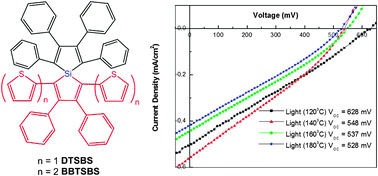2,5-Thiophene substituted spirobisiloles – synthesis, characterization, electrochemical properties and performance in bulk heterojunction solar cells†
Abstract
New

* Corresponding authors
a
Institut Charles Gerhardt Montpellier ICGM, UMR 5253, CNRS-UM2-ENSCM-UM1, Equipe CMOS, Université Montpellier 2, Bâtiment 17, CC 1701. Place E. Bataillon, 34095 Montpellier Cedex 5, France
E-mail:
sebastien.clement02@univ-montp2.fr, philippe.gerbier@univ-montp2.fr
Fax: +33 4 6714 3852
Tel: +33 4 6714 4501
b Université de Bordeaux, Laboratoire IMS, UMR CNRS 5218, Ecole Nationale Supérieure de Chimie, Biologie et Physique, 16 Avenue Pey Berland, 33607 Pessac Cedex, France
c Université de Rennes 1, CNRS UMR 6226, Institut des Sciences Chimiques de Rennes - MaCSE group, Bat. 10C, Campus de Beaulieu, 35042 Rennes Cedex, France
New

 Please wait while we load your content...
Something went wrong. Try again?
Please wait while we load your content...
Something went wrong. Try again?
K. Amro, A. K. Thakur, J. Rault-Berthelot, C. Poriel, L. Hirsch, W. E. Douglas, S. Clément and P. Gerbier, New J. Chem., 2013, 37, 464 DOI: 10.1039/C2NJ40535K
To request permission to reproduce material from this article, please go to the Copyright Clearance Center request page.
If you are an author contributing to an RSC publication, you do not need to request permission provided correct acknowledgement is given.
If you are the author of this article, you do not need to request permission to reproduce figures and diagrams provided correct acknowledgement is given. If you want to reproduce the whole article in a third-party publication (excluding your thesis/dissertation for which permission is not required) please go to the Copyright Clearance Center request page.
Read more about how to correctly acknowledge RSC content.
 Fetching data from CrossRef.
Fetching data from CrossRef.
This may take some time to load.
Loading related content
